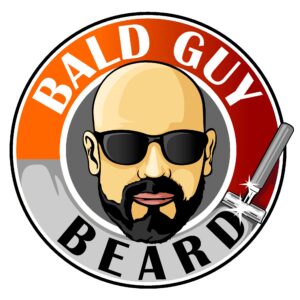Razor bumps tend to be caused either because of hereditary reasons or because of shaving mistakes and shaving habits. They appear as inflamed bumps on our skin typically after shaving and might also appear like a zit. They often hurt and can cause a cut the next time you shave if you shave over it.
Some men are more likely to get razor bumps than others. Hair grows in cycles and the methods of hair removal we use, our heredity and our shaving choices can all play a role in whether we get ingrown hairs and razor bumps.
Essential oils come from plants and have benefits related to skincare including shaving. Many guys assume essential oils are for women only and they might not be familiar with specific essential oils, their uses, and benefits.
Let’s learn more about essential oils, hair growth, razor bumps and how you can reduce the chances you get them.
How To Use Essential Oils For Razor Bumps

Some essential oils are believed to assist with skincare repair and maintenance. Always follow the instructions of the essential oil you’re using as many have specific dilution ratios and instructions for use.
Also check with your doctor to see if there might be a better way to deal with your specific situation. Some essential oils can irritate the skin and cause reactions, too.
You’ll often hear the use of the term “carrier oil” when speaking of essential oils. Carrier oils are used to “carry” the essential oil to the skin by diluting it. Common carrier oils include coconut oil and jojoba oil. More on those two below.
Here are some of the potential benefits that essential oils can offer for shavers with razor bumps.
Anti-inflammation
Ingrown hairs and razor bumps inflame the skin and may cause it to turn red and swell. Certain essential oils can assist with inflammation and reduce swelling, perhaps speeding up healing. A 2010 study showed that thyme, clover, rose, eucalyptus, fennel and bergamot are essential oils with anti-inflammation properties. Other popular oils believed to reduce inflammation include:
Tea Tree Oil: Tea Tree Oil has received a great deal of attention over the past number of years and is easily found online and in stores. This essential oil is widely used as an antiseptic and for its perceived inflammation properties. It’s a popular ingredient in body washes, face masks as well as shaving gel and cream.
Chamomile: You’ve possibly had chamomile tea. People like to drink it for the taste and for its perceived soothing nature. Homeopaths often used chamomile for anti-inflammation benefits and it’s possible it can help with both razor bumps and razor burn.
Moisturizing
Moisturizing your skin is important for guys who shave their head especially during periods of severe sun (summer) and severe cold (winter). It’s important for your face for the same reasons, especially when considering shaving.
Ylang Ylang: This oil tends not to get mentioned nearly as much as some of the others we’re discussing. Ylang Ylang is know for its ability to balance sebum (oil) production while also retaining skin moisture. It’s a great choice for guys with combination skin: you have oily skin in some places, dry skin in another.
Sweet Almond Oil: Made from the dried kernels of sweet almonds. Sweet Almond Oil is easily absorbed by the skin and is a good moisturizer for dry skin. It may be used after shaving for skin soothing benefits. It’s often used as a carrier oil too so it may be combined with another essential oil for multiple benefits.
Pores
Certain lotions and oils clog the pores (comedogenic products) and should be avoided especially for guys with oily skin. Other essential oils can help to shrink pores while not clogging them. The clogging of pores is what leads to razor bumps.
Witch Hazel: Witch Hazel is an astringent which means it can help to shrink pores and your soothe skin while also providing anti-inflammation properties. It also helps to remove oils from the skin. Some guys may use Witch Hazel following shaving to tighten skin and to protect against future razor bumps. Having tried this one myself, I certainly noticed the drying ability and tightening of pores particularly around the nose.
Patchouli: Perhaps not as well known to guys as other essential oils, Patchouli has anti-inflammation and antiseptic properties. Plus it’s an astringent which helps to shrink the size of pores.
Oily Skin
Coconut oil is highly comedogenic and should be avoided by guys with oily skin especially on the nose and face areas as it can clog pores further. I tried shaving with coconut oil as a test and found it to be very greasy.
Jojoba Oil: It’s actually a wax and is very close to the makeup of sebum, our own skin oil. Using Jojoba oil can trick our body into slowing down our own sebum production. Often, washing too much has the effect of increasing sebum production and increasing our oily skin thus making it worse. Using Jojoba oil following washing helps to ensure our body doesn’t over compensate and increase oil production.
The aforementioned Tea Tree Oil and Witch Hazel can also assist with oily skin.
So yes you can use essential oil to help your ingrown hairs while assisting with your skincare in general. But you can also do things to reduce the chances you get ingrown hairs and razor bumps in the first place.
The Relationship Between Ingrown Hairs, Hair Growth & Hair Removal

Row 2: The life cycle of hair.
Row 3: Various hair removal options. Shaving provides the shortest hairlessness.
Healthy hair grows out of the hair follicle above the skin. An ingrown hair grows out of the follicle and then curls back and grows back beneath the skin becoming an ingrown hair.
The middle row shows the distinct hair growth cycles. It helps to explain why ingrown hairs might appear individually or perhaps in a bunch at the same time. Hairs are growing independently of each other but within the same cycle phases.
The hair removal choices we make help to determine how likely we are to get ingrown hairs and razor bumps.
Shaving tends to give us 1-2 days before we need to shave again. If you use 2+ blades and/or lift-and-cut shavers that lift the hairs and cut them below the skin, they may grow back as ingrown hairs.
Cream depilation dissolves hairs at skin level. Not much chance of ingrown hairs.
Epilation removes the entire hair from the follicle. Not only does hair regrowth take longer, it can lead to ingrown hairs since like multi-blade shavers, the hair grows back from beneath the skin.
Waxing removes hair by the root and laser or Intense Pulsed Light (IPL) hair removal kills the entire hair. In all three cases, the new hair grows back below the skin, which can lead to ingrown hairs. In my experience, waxing and IPL both caused me to temporarily have ingrown hairs shortly after the treatment. It disappeared once the hairs freed themselves.
So now that we’ve discussed that, let’s talk more about the 3 main reasons you get ingrown hairs and razor bumps.
Heredity
Men of African and Indo-European ancestry tend to be more at risk of getting razor bumps. Men who have curly or coarse facial hair in general are also at increased risk.
In both cases as you see in the graphic above, curly hair tends to be more likely to curl back and grow underneath the skin leading to a razor bump. The associated inflammation and zit often follows.
Shaving Mistakes
Using dull razors. Buying cheap razor blades. Shaving the same area of skin repeatedly. Dry shaving without shaving cream. Shaving too quickly and aggressively by pressing too hard on the razor. These are the main reasons that razor bumps occur due to shaving habits.
These can all be corrected.
Technology

Single blade. Twin blade. 3 blades. 4 blades. 5 blades. 6 blades. 7 blades (!). How many do you need on a razor?
And yes, there is a 7-blade razor currently available. The most I’ve used in my life was 3 blades.
Shaving tends to make us hair free for several days at best. If we shave at skin level with a regular single blade razor or Double Edge (DE) single blade razor, the likelihood that it leads to ingrown hairs is low.
Decrease The Chance Of Ingrown Hairs And Razor Bumps
We can’t do anything about heredity of course. But we can exfoliate which may help to loosen ingrown hairs, remove dead skin, keep follicles open and decrease the chance of ingrown hairs. Use a face scrub or face wash to help remove dead skin which helps to keep pores open. Combine that with the relevant essential oil(s) listed above depending on your personal needs.
We can also stop doing all the things we talked about in the Shaving Mistakes section. A good quality Double Edge razor may help reduce the chances of ingrown hairs by cutting hair at skin level.
And staying away from the 2+ blade razors in general can also help reduce the chances of ingrown hairs and razor bumps. When we use the 2+ blade options, the first blade tends to lift and hold the hair and the second and subsequent blade(s) actually cut the hair, below skin level. Again, this can increase the chance for ingrown hairs.
Conclusion
- You can use various essential oils for shaving benefits to reduce inflammation and sooth red skin. They may also help to heal razor bumps quicker.
- Razor bumps are ingrown hairs that have curled down and grown back underneath the skin.
- Some men – those of African and Indo-European ancestry and men with naturally curly or coarse facial hair – are more at risk of ingrown hairs and razor bumps.
- Given that the above-mentioned shaving decisions are choices, they can be addressed and corrected.
- The heredity issue, not so much. So in that case all we can do is try to prevent razor bumps and deal with them if they occur. Essential oils may help in this regard along with a proper shaving and skincare regimen.
- Razor bumps and razor burn are not the same thing.
Do you experience frequent razor bumps? How do you deal with them? Have you had success with essential oil for razor bumps?


